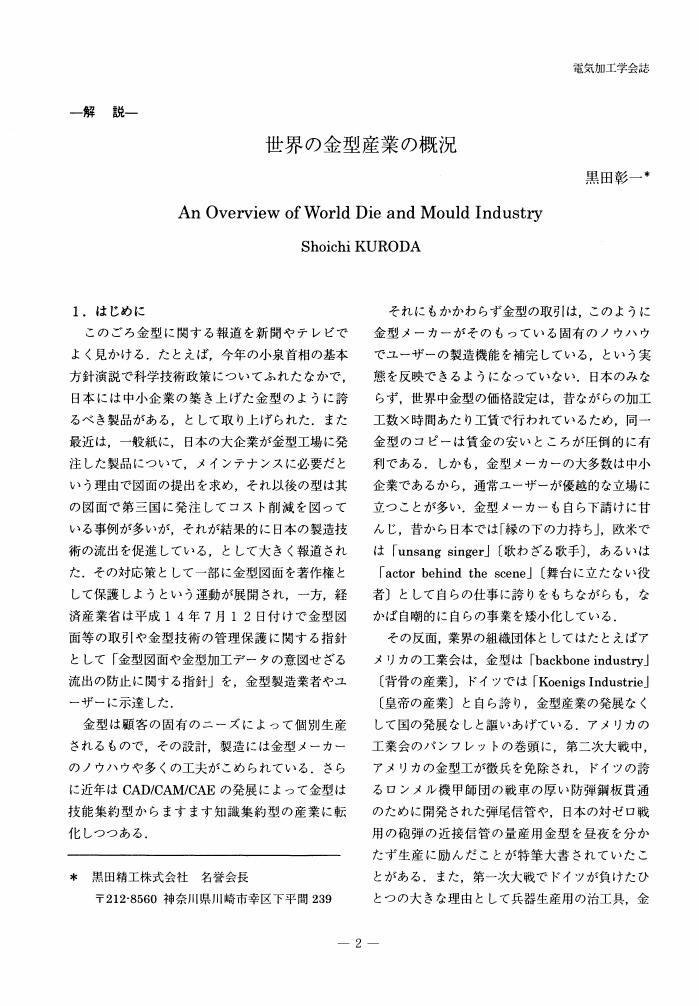2 0 0 0 OA 放電加工の妨害波について
- 著者
- 土屋 政光
- 出版者
- 一般社団法人 電気加工学会
- 雑誌
- 電気加工学会誌 (ISSN:0387754X)
- 巻号頁・発行日
- vol.18, no.35, pp.46-52, 1984-09-30 (Released:2010-03-12)
- 参考文献数
- 3
1 0 0 0 OA 放電加工に使用する電極材料について
- 著者
- 酒井 洋三 大場 信昭 小川 元 安田 治 加藤木 英隆
- 出版者
- Japan Society of Electrical Machining Engineers
- 雑誌
- 電気加工学会誌 (ISSN:0387754X)
- 巻号頁・発行日
- vol.38, no.87, pp.7-11, 2004-03-26 (Released:2010-03-12)
- 参考文献数
- 4
- 著者
- Yoshiyuki UNO Osamu ENDO Tbshikatsu NAKAJIMA
- 出版者
- Japan Society of Electrical Machining Engineers
- 雑誌
- Journal of The Japan Society of Electrical Machining Engineers (ISSN:0387754X)
- 巻号頁・発行日
- vol.25, no.49, pp.9-22, 1991-07-20 (Released:2010-03-12)
- 参考文献数
- 13
- 被引用文献数
- 2
The purpose of this study is to make clear the crater generation mechanism in electrical dischage machining with a single pulse method, investigating the impact force acting on the workpiece, the shape of crater, the discharge current, the surface of crater, the removed chip and so on. Main conclusions obtained are as follows:(1) The impact force acting on the workpiece in a single pulse dischage reaches a maximum value after a few micro seconds from the beginning of spark regardless of the discharge duration.(2) The melted volume by a single pulse discharge has a close relation to the discharge energy, and the relation in the air is identical with that in the dielectric fluid.(3) The metal removal in a single pulse discharge is mainly caused by melting and vaporization of material for the discharge duration over 10 micro seconds, while impact operation plays main role for the discharge duration under 10 micro seconds.(4) Spherical chip produced in electrical discharge includes the composition of tool electrode material, while fragmental chip doesn't.
1 0 0 0 OA 世界の金型産業の概況
- 著者
- 黒田 彰一
- 出版者
- 一般社団法人 電気加工学会
- 雑誌
- 電気加工学会誌 (ISSN:0387754X)
- 巻号頁・発行日
- vol.36, no.83, pp.2-8, 2002-11-29 (Released:2010-03-12)
1 0 0 0 OA 絶縁性 SiC セラミックスのワイヤ放電加工特性
- 著者
- 金子 健正 福澤 康 山田 隆一
- 出版者
- 一般社団法人 電気加工学会
- 雑誌
- 電気加工学会誌 (ISSN:0387754X)
- 巻号頁・発行日
- vol.46, no.113, pp.126-132, 2012 (Released:2013-08-03)
- 参考文献数
- 7
- 被引用文献数
- 1
Many insulating ceramic materials, such as Si3N4, ZrO2, and Al2O3, and the single-crystal materials ruby, sapphire, and diamond, could be machined by EDM and WEDM with the assisting electrode method. WEDM with the assisting electrode method has successfully machined various insulating ceramics materials, such as Si3N4 and ZrO2, up to a thickness of 100mm, but it has not been successful for SiC with a high melting point and a high thermal conductivity. In this study, the effects of the wire electrode material on machining properties were examined to obtain better machining properties such as a high removal rate and a low machined surface roughness. As a result, the machining characteristics were improved compared with those observed in previous trials. The discharge behavior was discussed by considering discharge waveforms and EDMed surface conditions.


